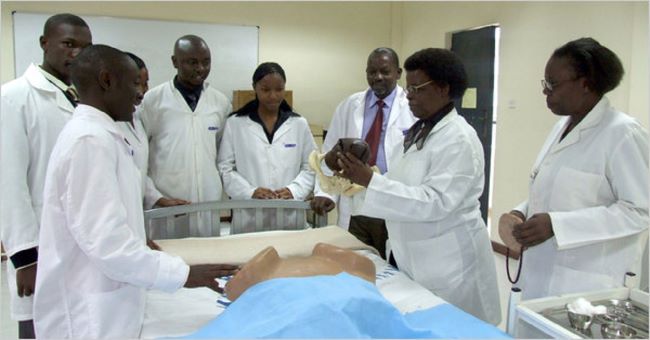28, November 2021
France on the ropes: Two killed as Africans confront military convoy 0
At least two people have been killed and 18 others wounded after French forces fired shots to disperse angry protesters blocking a French military convoy in western Niger.
The armored vehicles and logistics trucks had crossed the border on Friday after being blocked in Burkina Faso for a week by demonstrations there against French forces’ failure to stop mounting violence by Takfiri militants.
Anger has been rising against the French military presence in Niger, Burkina Faso and other countries in West Africa’s Sahel region.
Last weekend, hundreds of people in the Burkinabe city of Kaya blocked the French convoy, which is on its way from Ivory Coast to Mali.
It was able to leave Burkina Faso on Friday but ran into new protests on Saturday morning less than 30 km across the border in the western Niger town of Tera, where it was confronted by protesters.
Video shared by a local official showed the protesters chanting “Down with France,” as black smoke rose from a burning barricade.
“In its attempt to extricate itself, it (the French forces) used force. Sadly, we deplore the death of two people and 18 injuries, 11 of them serious,” Niger’s interior ministry said in a statement.
French military spokesperson Pascal Ianni admitted that soldiers had “fired warning shots” and tear gas at protesters, but dismissed as “false information” reports on social media that French forces had killed civilians in Tera.
Ianni said the convoy eventually crossed the town and continued toward the capital, Niamey.
France intervened in Mali in 2013 to purportedly beat back militants who had seized the desert north, before deploying soldiers across the Sahel. While it has deployed more troops, violence has continued to intensify and spread in the region.
In the demonstrations in Burkina Faso and elsewhere, protesters have cited widespread belief that France is secretly supporting the militants to justify its continued military presence in its former colonies.
Rise of anti-colonial sentiments
France has been one of the world’s colonizing countries that after many years of slavery still controls countries spread over more than 12 territories and treats their people as second-class citizens.
The Caribbean territory of Guadeloupe and nearby Martinique have recently been wracked by rioting and strikes that reflect long-running frustrations over inequality with the French mainland.
France’s minister for overseas affairs, Sebastien Lecornu, on Friday said Paris was ready to discuss some autonomy for Guadeloupe, but the overnight offer drew sharp criticism Saturday from conservative and far right candidates for France’s April presidential election.
Guadeloupe uses the euro currency and has close political ties with the mainland. But high unemployment in Guadeloupe and Martinique, high costs of living and lingering anger over historical abuses have prompted some local officials to demand change.
A third of the Guadeloupe population lives below the poverty line, and unemployment rate is 17%. The cost of living, meanwhile, is high because the island relies heavily on imports from the mainland. Water supplies have been a major problem in recent years because of obsolete pipes.
Some residents denounce a relationship with Paris reminiscent of colonial times, and note an ongoing scandal over the use of a dangerous pesticide on islands in the Antilles for years after it was banned on the mainland.
Many people were systematically exposed to toxic pesticides used in banana plantations in the 1970s in Martinique and Guadeloupe.
The product was banned in the US in 1976 and in France in 1990, but special provisions were made for its continued use in the Caribbean territories until 1993.
There have been numerous attempts at autonomy since the Second World War, though none have been successful. The anger of people living in Guadeloupe is because a country 7,000 kilometers away is governing them, constantly treating them as second-class citizens.
Guadeloupe receives 972 million euros from the EU each year, but its youth-unemployment rate has hovered around 50 percent for decades.
Source: Presstv



























28, November 2021
Southern Cameroons Crisis caused a cumulated XAF412 bln loss in GDP in 2017-2020 0
The anglophone crisis dragged growth down by 0.8 and 0.3 points of GDP respectively in 2019 and 2020 in Cameroon. This represents a cumulated loss in GDP estimated at XAF421.3 billion between 2017 and 2020.
The figures were presented on November 23, 2021, by Paul Tasong, Minister Delegate to the Minister of Economy Planning and Regional Development, while presenting the presidential plan for the reconstruction of the anglophone regions.
For Paul Tasong, the poor performance was due to decline in business in several sectors, the most affected being the agricultural sector.
For instance, the paddy rice segment recorded an average of 14.5% drop in activities yearly between 2017 and 2019 before rising by about 10% in 2020. Meanwhile, crude palm oil production dropped by about 90% over the period, going from 37,400 tons in 2016 to about 4 300 tons in 2019. “In 2020, however, there was a reverse in the downtrend with a 131% rise in the production of palm oil to reach 9 900 tons,” Paul Tasong explained.
Regarding the banana sector, production dropped from 125,019 tons in 2016 to 16,897 tons in 2019 in the South West because state firm Cameroon Development Corporation (CDC) stopped operations in 2018.
“However, production recovered in 2020 to 21,132 tons. In the first half of 2021, the company produced nearly 16,272 tons of bananas,” the delegated Minister added.
As far as consumer products are concerned, fish supplies dipped significantly in the regions in 2019 before stabilizing in 2020 that saw a 14.6% rise in the Northwest and 25.3% in the Southwest, we learn.
Industry
The poor performance of manufacturing industries in the anglophone regions caused a decline in medium-voltage energy consumption in the order of 19.5%, 6%, and 25%, respectively in 2017, 2018, and 2019. The resumption in activities recorded in the manufacturing industries 2020 resulted in a 7% rise in the consumption of that type of energy, Paul Tasong continued.
He further explained that the cocoa and tourism sectors were impacted as well. Also, due to the crisis, a significant number of public projects worth XAF16.4 billion were not executed during the 2017-2019 period despite the increase in budgets allocated. In that context, the public investment budget implementation rate remained relatively low in the North-West and South-West regions (the estimated average is 64.4% and 68.2 respectively) between 2017 and 2019. In 2020, that rate improved notably to 83.7% in the North-west and 89.9% in the South-west.
According to the GICAM, the largest employers’ grouping in Cameroon, from 2016 to date, companies have lost an estimated XAF800 billion.
Source: Business in Cameroon